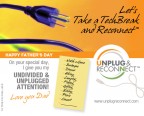 If your children are a little too plugged in to technology, you might have noticed some unwanted side effects. Digital overload has been associated with a host of problems, including attention difficulties, low grades, impaired sleep, obesity and withdrawal from family life, among others.
If your children are a little too plugged in to technology, you might have noticed some unwanted side effects. Digital overload has been associated with a host of problems, including attention difficulties, low grades, impaired sleep, obesity and withdrawal from family life, among others.
But there are practical things you can do as a parent to help wean your child from technology overuse. Here are a few ideas:
- Know how much is too much. The American Academy of Pediatrics says that young children shouldn’t spend more than two hours a day plugged into technology. If your child is spending more than that – and the average child does spend an average of eight hours – it’s time to set limits.
- Declare ‘Unplug and Reconnect’ time. Specify a special tech-free time of day. Enjoy a meal without interruptions. Plan a family game night. The goal is to disconnect from technology and to find time to reconnect with your family.
- Offer alternatives. Help your child develop a list of entertaining, technology-free games and other activities they could do by themselves or with the family. Show them that there’s a world of fun beyond the Internet.
- Get moving. Today’s technology-addicted children are more sedentary than is good for them – which may explain why childhood obesity and Type II diabetes rates are soaring. Encourage physical play – perhaps even a family touch football game now and then.
- Foster a balance. Establish a rule that technology use must be balanced with other activities. Tell your children that every hour spent surfing the Internet must be offset by an hour playing a non-technological activity.
- Set a good example. Your children will often emulate your behavior. If you think they’ve become too consumed by technology, make sure that the same isn’t true of your own technology use.



